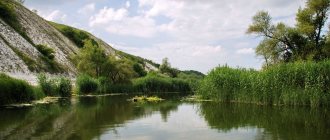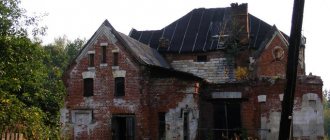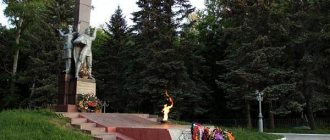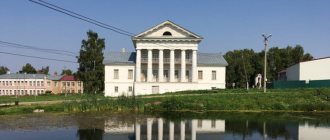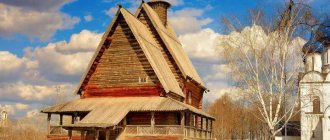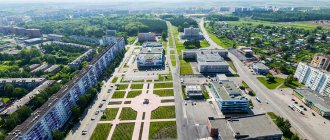This term has other meanings, see Krasnogorsk region.
| city of regional subordination with administrative territory[1] / urban district[2] | |
| Krasnogorsk city Krasnogorsk urban district | |
| Flag | Coat of arms |
- (2,98 %)
Krasnogorsky district
- an administrative-territorial unit (district) and a municipal entity of the same name (municipal district), which existed until the beginning of 2022 in the central part of the Moscow region of Russia.
On January 9, 2022, by law No. 186/2016-OZ, the municipal formation of the Krasnogorsk municipal district was transformed into the municipal formation of the Krasnogorsk urban district
with the abolition of all previously included settlements.[5]
On April 23, 2022, the administrative-territorial unit of Krasnogorsk district was transformed into the city of regional subordination of Krasnogorsk
with administrative territory.[6][7]
The administrative center is the city of Krasnogorsk[3].
Population
| Population | ||||||
| 1939[9] | 1959[10] | 1970[11] | 1979[12] | 1989[13] | 2002[14] | 2006[15] |
| 165 542 | ↗169 100 | ↘54 973 | ↘53 891 | ↘51 823 | ↗149 679 | ↘149 610 |
| 2009[16] | 2010[17] | 2011[18] | 2012[19] | 2013[20] | 2014[21] | 2015[22] |
| ↗156 719 | ↗179 872 | ↗188 105 | →188 105 | ↗194 504 | ↗200 576 | ↗207 836 |
| 2016[23] | 2017[4] | |||||
| ↗217 404 | ↗231 673 | |||||
Large-scale housing construction is taking place on the territory of the municipality, and this is associated with an influx of residents from other constituent entities of the federation (including Moscow). The new Pavshinskaya Poyma microdistrict, built on the site of former agricultural land, is home to about 50 thousand residents[24]. In 2008, construction began on a new residential complex, Spassky Most, and in 2010, on the Emerald Hills microdistrict with a housing area of about 800 thousand m³.
Most of the residents of new microdistricts are currently, for various reasons, not yet reflected in official statistics and will only be taken into account from the time of the next population census in 2022. After the unification into the Krasnogorsk urban district, the construction and housing and communal services divisions of the district administration gave an expert assessment of the number of square meters of inhabited living space, from which it follows that 317 thousand people permanently live in the Krasnogorsk urban district[25].
95.95% of the district’s population live in urban areas (the city of Krasnogorsk and the working village of Nakhabino).
Crime
There is crime in Krasnogorsk. Well, where would we be without him? Every day about a dozen crimes happen in the city, which have even become the norm.
In the first place are thefts and they come in different forms. For example, ordinary hard workers are not averse to stealing some expensive device, such as a drill or electric saw, from their place of work. The type of theft for which a person of any social status can be convicted is the removal of unpaid goods from stores. It’s not even greed that plays the main role here, but the habit of “taking what’s bad.” Many people automatically put some small item in their pocket, such as a chocolate bar, and then, forgetting about it, end up at the police station.
Apartment burglaries also happen in Krasnogorsk, and there was a case when the door was simply kicked in, all valuables were taken and they left. Nobody saw anyone.
Second place should be given to petty hooliganism. In general, “go-stop”! They came around the corner, and then the victim doesn’t really remember anything: he was left without a wallet or a mobile phone.
In third place are car thefts, as well as fraud using credit cards and mobile communications.
As for other types of crimes, we can simply say: they happen, but the less often the better.
Municipal-territorial structure
Cartographic description of the boundaries of settlements in the Krasnogorsk district, approved by the law of the Moscow region.
From 2006 to 2022, the Krasnogorsk municipal district included 4 municipalities, including 2 urban settlements and 2 rural settlements:
| № | Municipality | Administrative center | Number of settlements | Population (persons) | Area (km²) |
| 1e-06 | Urban settlement: | ||||
| 1 | Krasnogorsk | Krasnogorsk city | 3 | ↗153 672[4] | 59,52[26] |
| 2 | Nakhabino | working village of Nakhabino | 4 | ↗43 025[4] | 60,42[26] |
| 2.000002 | Rural settlement: | ||||
| 3 | Ilyinskoe | village Ilyinskoye | 21 | ↗22 165[4] | 76,16[26] |
| 4 | Otradnenskoye | Otradnoe village | 9 | ↗12 811[4] | 28,89[26] |
On January 9, 2022, the settlements were abolished with the transformation of the municipal district into an urban district.
A sculptor lives here, whose works are in the Leonardo da Vinci Museum
Indeed, the works of the Krasnogorsk artist Valentin Yakovlevich Vorobyov were highly appreciated by world museums. The French Louvre wanted to buy his sculpture “Grace”, but Vorobiev decided to keep this work for himself. But he donated one of his sculptures to the Italian Leonardo da Vinci Museum.
The artist lives in the village of Korostovo. He creates his sculptures from metal - Valentin Yakovlevich is a hereditary blacksmith. Some of his works are unique, in which the artistic image is surprisingly combined with a mechanism; such sculptures move. You can see them in the Iron Kingdom museum (Krasnogorsk, Korostovo village, 24).
Modern Krasnogorsk remembers its history
Settlements
| № | Locality | Type | Population | former municipality |
| 1 | Alexandrovka | village | ↘199[27] | rural settlement Ilyinskoye |
| 2 | Angelovo | village | ↗243[27] | rural settlement Otradnenskoye |
| 3 | Aristovo | village | ↘36[27] | rural settlement Otradnenskoye |
| 4 | Arkhangelskoe | village | ↗4443[27] | rural settlement Ilyinskoye |
| 5 | Buzlanovo | village | ↘162[27] | rural settlement Ilyinskoye |
| 6 | Funnels | village | ↗182[27] | rural settlement Ilyinskoye |
| 7 | Gavrilkovo | village | ↗344[27] | rural settlement Otradnenskoye |
| 8 | Glukhovo | village | ↗291[27] | rural settlement Ilyinskoye |
| 9 | Golyevo | village | ↗491[27] | urban settlement Krasnogorsk |
| 10 | Gribanovo | village | ↗92[27] | rural settlement Ilyinskoye |
| 11 | Dacha farm "Arkhangelskoye" | village | ↗1263[27] | rural settlement Ilyinskoye |
| 12 | Dmitrovskoe | village | ↗602[27] | rural settlement Ilyinskoye |
| 13 | Zhelyabino | village | ↗131[27] | urban settlement Nakhabino |
| 14 | Zakharkovo | village | ↗470[27] | rural settlement Ilyinskoye |
| 15 | Ivanovskoe | village | ↘129[27] | urban settlement Krasnogorsk |
| 16 | Ilyinskoe | village | ↘478[27] | rural settlement Ilyinskoye |
| 17 | Ilyinskoye-Usovo | village | ↘1504[27] | rural settlement Ilyinskoye |
| 18 | Engineering-1 | village | ↗1134[27] | rural settlement Ilyinskoye |
| 19 | Istra | village | ↘1173[27] | rural settlement Ilyinskoye |
| 20 | Kozino | village | ↗595[27] | urban settlement Nakhabino |
| 21 | Korostovo | village | ↗247[27] | rural settlement Otradnenskoye |
| 22 | Krasnogorsk | city | ↗175 812[28] | urban settlement Krasnogorsk |
| 23 | Maryino | village | ↗149[27] | rural settlement Otradnenskoye |
| 24 | Mechnikovo | village | ↗2427[27] | rural settlement Ilyinskoye |
| 25 | Mikhalkovo | village | ↗39[27] | rural settlement Ilyinskoye |
| 26 | Nakhabino | workers' village | ↗46 487[29] | urban settlement Nakhabino |
| 27 | Nefedyevo | village | ↗31[27] | urban settlement Nakhabino |
| 28 | Nikolo-Uryupino | village | ↗693[27] | rural settlement Ilyinskoye |
| 29 | New | village | ↗2237[27] | rural settlement Ilyinskoye |
| 30 | Otradnoe | village | ↘1233[27] | rural settlement Otradnenskoye |
| 31 | Petrovo-Dalnee | village | ↗2001[27] | rural settlement Ilyinskoye |
| 32 | Pozdnyakovo | village | ↗273[27] | rural settlement Ilyinskoye |
| 33 | Putilkovo | village | ↗2464[27] | rural settlement Otradnenskoye |
| 34 | Saburovo | village | ↗145[27] | rural settlement Otradnenskoye |
| 35 | Svetlye Gory | village | →422[27] | rural settlement Otradnenskoye |
| 36 | Stepanovskoe | village | ↗95[27] | rural settlement Ilyinskoye |
| 37 | Timoshkino | village | ↗102[27] | rural settlement Ilyinskoye |
Story
The Krasnogorsk district was formed in September 1932 by transforming the Skhodnensky district. On October 7, 1940, by decree of the Presidium of the Supreme Soviet of the RSFSR, the working village of Krasnogorsk, which at that time had 20 thousand inhabitants, was transformed into a city.
Krasnogorsk district within the borders of 1939
In early December 1941, German troops approached Moscow and entered the territory of the Krasnogorsk region. For several days there were battles near the villages of Kozino and Nefedyevo, and on December 5 the Red Army counteroffensive began, and the German army was thrown back to the west.
History of administrative divisions
Krasnogorsk district was formed on September 27, 1932. It included:
- from the Skhodnensky district: working villages of Krasnogorsky, Krasnooktyabrsky, Novobrattsevsky; dacha village of Khimki; village councils Aksininsky, Angelovsky, Brattsevsky, Businovsky, Dudinsky, Zakharkovsky, Kurkinsky, Mitinsky, Nikolsky, Novoluzhinsky, Pavshinsky, Penyaginsky, Petrovo-Lobanovsky, Pokrovsko-Glebovsky, Putilkovsky, Saburovsky, Spassky, Tushinsky, Khimkinsky, Chernevsky, Yurlovsky
- from the Istrinsky district village councils Buzlanovsky, Voronkovsky, Zakharovsky, Ilyinsky, Nikolo-Uryupinsky, Novonikolsky, Petrovsky
- from the Kuntsevo district, Glukhovsky village council.
On January 7, 1934, the r.p. was formed. Tushino, and Zakharkovsky and Tushinsky s/s were abolished. On April 27, the Pokrovskoe-Glebovo dacha settlement was formed, and the Pokrovsko-Glebovo s/s was abolished.
On March 31, 1936, the dacha village of Khimki was transformed into a workers' village.
June 5, 1938 r.p. Tushino received the status of a city of regional subordination. On November 3, a d.p. was formed. Novo-Khovrino. On December 1, r.p. were formed. Knitted and Nikolsky. At the same time, the Nikolsko-Vsekhsvyatsky s/s was abolished. On December 13, the dacha village of Pokrovskoye-Glebovo was transformed into a workers’ village.
February 23, 1939 r.p. Khimki was transformed into a city. August 21 r.p. Krasnogorsk was transformed into the city of Krasnogorsk.
On May 28, 1940, the Khimki district was formed. The city of Khimki was transferred to its composition from the Krasnogorsk region; r.p. Krasnooktyabrsky and Nikolsky; d.p. Novo-Khovrino; village councils Aksininsky, Businovsky, Kurkinsky, Novoluzhinsky, Petrovo-Lobanovsky, Khimkinsky and Yurlovsky.
On March 18, 1944, the city of Tushino was transferred from the Krasnogorsk region to regional subordination. At the same time, the r.p. was attached to Tushino. Pokrovsko-Glebovsky. On June 9, the r.p. was annexed to Tushino. Knitted.
On May 9, 1952, a d.p. was formed. Opalikha.
On June 14, 1954, Angelovsky, Glukhovsky, Dudinsky, Zakharkovsky, Mitinsky, Nikolo-Uryupinsky, Penyaginsky, Petrovo-Dalnevsky, Putilkovsky, Saburovsky and Chernevsky s/s were abolished. Maryinsky s/s was formed.
On December 7, 1957, the Istrinsky district was abolished. From it the cities of Istra and Dedovsk entered the Krasnogorsk region; r.p. Nakhabino; d.p. Bullfinches; village councils Buzharovsky, Bukarevsky, Velyaminovsky, Davydovsky, Dukhaninsky, Ermolinsky, Ivanovsky, Kostrovsky, Leninsky, Luchinsky, Obushkovsky and Pavlo-Slobodsky.
On December 30, 1959, Buzlanovsky, Velyaminovsky, Novonikolsky and Spassky s/s were abolished.
On August 18, 1960, the Krasnogorsk district was seriously reorganized. The cities of Istra and Dedovsk were transferred to the restored Istra region; d.p. Bullfinches; village councils Buzharovsky, Bukarevsky, Davydovsky, Dukhaninsky, Ermolinsky, Ivanovsky, Kostrovsky, Leninsky, Luchinsky, Obushkovsky and Pavlo-Slobodsky. Brattsevsky s/s entered the city limits of Moscow. From the abolished Khimki district, Klyazminsky, Molzhaninovsky, Novoluzhinsky and Starbeevsky s/s were transferred to Krasnogorsky. From the abolished Kuntsevo district to Krasnogorsk, village settlements were transferred. Bakovka and Nemchinovka, as well as the village councils of Barvikhinsky, Mamonovsky and Novoivanovsky. At the same time, the Krasnogorsk district was subordinate to the Moscow City Council.
On August 18, 1960, the Krasnogorsk district was renamed Istra, the city of Istra was approved as the center of the district, while the city of Istra was classified as a city of regional subordination (Decree of the Presidium of the Supreme Council of the RSFSR) (Gazette of the Supreme Council of the RSFSR. - 1960. - No. 30 (101) dated 25 August. - P. 425).
On November 12, 1960, Novoluzhinsky s/s was renamed Rodionovsky.
On January 20, 1961, the city of Khimki was annexed to the Krasnogorsk region. On November 11, the Krasnogorsk district was removed from the subordination of the Moscow City Council and returned to the Moscow region.
On April 28, 1962, the city of Khimki was removed from the Krasnogorsk region. On July 31, Starbeevsky s/s was abolished.
On February 1, 1963, the Krasnogorsk district was abolished. At the same time, Krasnogorsk became a city of regional subordination (the settlements of Nakhabino and Novobrattsevsky and the settlement of Opalikha were also subordinated to it); Barvikhinsky, Voronkovsky, Ilyinsky, Mamonovsky, Maryinsky, Novoivanovsky and Pavshinsky s/s were transferred to the Zvenigorod enlarged rural district, and Klyazminsky, Molzhaninovsky and Rodionovsky s/s - to Solnechnogorsk enlarged rural district.
On January 13, 1965, the Krasnogorsk district was restored. It included r.p. Nakhabino and Novobrattsevsky; d.p. Opalikha; village councils Voronkovsky, Ilyinsky, Maryinsky and Mitinsky.
On August 22, 1979, Petrovo-Dalnevsky s/s was formed.
On March 19, 1984, the villages of the Mitinsky Plant and Novotushino, the villages of Rozhdestveno and Spas, the villages of Mitino and Penyagino of the Mitinsky Village Council with a total area of 1.2 thousand hectares were transferred to the administrative subordination of the Moscow City Council of People's Deputies (Decree of the Presidium of the Supreme Council of the RSFSR) (Vedomosti Supreme Council of the RSFSR. - 1984. - No. 12 (1326) dated March 22. - P. 270-271), and on December 11, 1985 they were included in the city of Moscow (Decree of the Presidium of the Supreme Council of the RSFSR) (Gazette of the Supreme Council of the RSFSR. - 1985. - No. 51 (1417) dated December 19. - P. 1252).
On December 18, 1990, the Novobrattsevsky settlement with a total area of 33.4 hectares was included in the city of Moscow according to the presented schematic plan and description of the boundaries of this settlement (Decree of the Presidium of the Supreme Council of the RSFSR) (Gazette of the Congress of People's Deputies of the RSFSR and the Supreme Council of the RSFSR. - 1990. - No. 29 of December 20. - P. 578). At the same time, Putilkovsky s/s was created.
On February 3, 1994, village councils were transformed into rural districts.
On February 1, 2001, the city of Krasnogorsk lost its status as a city of regional subordination (Law of the Moscow Region of January 17, 2001 No. 12/2001-OZ, “Podmoskovnye Izvestia”, No. 20, 01.02.2001).
October 28, 2004 d.p. Opalikha was included within the city limits of Krasnogorsk[30].
On July 1, 2012, as part of the Moscow expansion project, an area of 570 hectares was transferred from the urban settlement of Krasnogorsk to the Kuntsevo district of Moscow CJSC. Together with the territory from the rural settlement of Barvikhinskoye, Odintsovo district, the transferred plots form the Rublevo-Arkhangelskoye site. Previously, it was also planned to transfer the village of Golyevo to this settlement, but these plans were abandoned.
On January 9, 2022, by law No. 186/2016-OZ, the municipal formation of the Krasnogorsk municipal district was transformed into the municipal formation of the Krasnogorsk
with the abolition of all 2 urban and 2 rural settlements that were previously included in it.[5]
On April 23, 2022, the administrative-territorial unit of Krasnogorsk district was transformed into the city of regional subordination of Krasnogorsk
with administrative territory.[6][7]
In April 2022, the legal procedure for the transfer of all 37 settlements of the Krasnogorsk district to the Krasnogorsk urban district will be completed.
On March 14, 2022, the rural settlements of Ilyinskoye and Otradnenskoye were abolished (Resolution of the Governor of the Moscow Region dated March 14, 2022 No. 87-PG, Official Internet portal of the Government of the Moscow Region https://www.mosreg.ru, 03/14/2017).
On March 29, 2022, the working village of Nakhabino was placed under administrative control of the city of Krasnogorsk (Resolution of the Governor of the Moscow Region dated March 29, 2022 No. 127-PG, Official Internet portal of the Government of the Moscow Region https://www.mosreg.ru, 03.29.2017).
On April 23, 2022, the city of Krasnogorsk was classified as a city of regional subordination of the Moscow region, and the Krasnogorsk district was abolished (Law of the Moscow Region dated April 7, 2022 No. 38/2017-OZ, Official Internet portal of the Government of the Moscow Region https://www.mosreg. ru, 04/12/2017).
Krasnogorsk is one of the most dynamically developing cities in Russia. In the rating of sustainable development of Russian cities, compiled on the basis of 32 statistical indicators by the SGM agency using the methods of McKinsey, Ernst&Young and others, based on the results of 2015, Krasnogorsk ranks 12th among 179 large cities in the country, right behind Tyumen, Surgut, Moscow, Krasnodar, Perm , St. Petersburg, Yekaterinburg, Kazan, Nizhnevartovsk, Nefteyugansk and Kursk[31].
Climate and ecology of Krasnogorsk
The climate of Krasnogorsk is not far from Moscow, except that it lost a couple of degrees along the way: it is still the same moderate continental with cold winters and warm summers. According to statistics, the average temperature in January is -9C°, and in July - +19C°.
There is no shortage of precipitation in the city: even short-term summer rain will slightly perk up the streets, and heavy snowfall will emphasize the onset of winter.
At the same time, the weather itself is unstable, so it can make Krasnogorsk residents swelter from the heat or cover everything with snow so that they have to, for example, dig out their own car, left to sleep in the open air. The good news is that there are practically no strong winds in the city, because this saves it from the dirty air that can come from the capital.
Winter on Ivanovo Ponds
The environmental situation in Krasnogorsk is only getting worse. This is due to the fact that forests are being cut down around, the air is being polluted because of the roads running through the city, and local enterprises, although not engaged in the chemical industry, still dispose of their waste somewhere.
By the way, it must be emphasized that it is in terms of ecology that Krasnogorsk is one of the most polluted cities near Moscow. At the same time, on the Internet, mostly on real estate websites, you can find information that Krasnogorsk is an ideal place to live, because there is a vast green area, rivers, practically waste-free factories and the absence of wind from the Moscow direction. At the same time, they are silent not only about the fact that forests are cut down specifically for construction, but also about the fact that many trees are diseased, and the city’s groundwater has long contained various chemical compounds.
In general, if you decide to move to Krasnogorsk, then get ready for the fact that you will live in an ordinary Moscow region, and not in some ecopolis.
Economy
Economic activity in the area is mainly related to manufacturing, construction; The role of small business is growing. In 2011, the volume of shipped goods of own production, work and services performed in-house amounted to 80.6 billion rubles (an increase of 18.6% compared to 2010), of which 44.5% was the share of industrial organizations. The most important enterprises of the region are OJSC Krasnogorsk Plant named after. S.A. Zverev", LLC "KNAUF GIPS", LLC "First Printing Plant", CJSC "Printing Complex "Extra-M", CJSC "Betsema", JSC "Biomed im. I. I. Mechnikov”, JSC “Krasnogorskleksredstva”. Retail trade turnover in 2011 amounted to about 50 billion rubles. (an increase of 11.5%)[32].
The number of people employed in the region's economy in 2011 was 64.2 thousand people, the registered unemployment rate at the end of this year was 0.4%. The average monthly salary in 2011 among those employed in the Krasnogorsk region was 32.3 thousand rubles. (an increase of 12.8% compared to the previous year), and in the public sector - 21 thousand rubles.[32]
The revenues of the district's consolidated budget in 2011 amounted to 5.3 billion rubles. (in 2010 - 5.1 billion rubles), 87% of budget expenditures were socially oriented. The projected volume of district budget revenues for 2012 is 5.7 billion rubles.[32]
Notes
- from the point of view of the administrative-territorial structure
- from the point of view of the municipal structure
- ↑ 12
Law of the Moscow Region dated February 28, 2005 No. 70/2005-OZ “On the status and boundaries of the Krasnogorsk municipal district and newly formed municipalities within it” - ↑ 123456
Population of the Russian Federation by municipalities as of January 1, 2022 (Russian) (July 31, 2017). Retrieved July 31, 2022. Archived July 31, 2022. - ↑ 12
Law “On the organization of local self-government in the territory of the Krasnogorsk municipal district” - ↑ 12
Law “On classifying the city of Krasnogorsk, Krasnogorsk district of the Moscow region, as a city of regional subordination of the Moscow region, abolishing the Krasnogorsk district of the Moscow region and amending the Law of the Moscow region “On the administrative-territorial structure of the Moscow region”” - ↑ 12
Law of the Moscow Region No. 11/2013-OZ dated January 31, 2013 “On the administrative-territorial structure of the Moscow Region” - Law of the Moscow Region No. 166/2017-OZ “On amendments to the Law of the Moscow Region “On the border of the Krasnogorsk urban district” and the Law of the Moscow Region “On the status and boundaries of the Odintsovo municipal district and newly formed municipalities within it””
- All-Union Population Census of 1939. The current population of the USSR by regions and cities (unspecified)
. Retrieved November 20, 2013. Archived November 16, 2013. - All-Union Population Census of 1959. The actual population of cities and other settlements, districts, regional centers and large rural settlements as of January 15, 1959 by republics, territories and regions of the RSFSR (unspecified)
. Retrieved October 10, 2013. Archived October 10, 2013. - All-Union population census of 1970. The actual population of cities, urban-type settlements, districts and regional centers of the USSR according to census data as of January 15, 1970 by republic, territory and region (unspecified)
. Retrieved October 14, 2013. Archived October 14, 2013. - All-Union Population Census of 1979. The current population of the RSFSR, autonomous republics, autonomous regions and districts, territories, regions, districts, urban settlements, village-district centers and rural settlements with a population of over 5,000 people (unspecified)
. - All-Union population census of 1989. Population of the USSR, RSFSR and its territorial units by gender (undefined)
. Archived from the original on August 23, 2011. - All-Russian population census 2002. Volume. 1, table 4. Population of Russia, federal districts, constituent entities of the Russian Federation, districts, urban settlements, rural settlements - regional centers and rural settlements with a population of 3 thousand or more (unspecified)
. Archived from the original on February 3, 2012. - Alphabetical list of settlements in municipal districts of the Moscow region as of January 1, 2006 (unspecified)
(RTF+ZIP). Development of local self-government in the Moscow region. Access date: February 4, 2013. Archived January 11, 2012. - The size of the permanent population of the Russian Federation by cities, urban settlements and regions as of January 1, 2009 (unspecified)
. Retrieved January 2, 2014. Archived January 2, 2014. - Population census 2010. Population of Russia, federal districts, constituent entities of the Russian Federation, city districts, municipal districts, urban and rural settlements (Russian). Federal State Statistics Service. Access date: February 9, 2013. Archived April 28, 2013.
- Moscow region. Estimated resident population as of January 1, 2009-2016
- Population of the Russian Federation by municipalities. Table 35. Estimated resident population as of January 1, 2012 (unspecified)
. Retrieved May 31, 2014. Archived May 31, 2014. - Population of the Russian Federation by municipalities as of January 1, 2013. - M.: Federal State Statistics Service Rosstat, 2013. - 528 p. (Table 33. Population of urban districts, municipal districts, urban and rural settlements, urban settlements, rural settlements) (undefined)
. Retrieved November 16, 2013. Archived November 16, 2013. - Table 33. Population of the Russian Federation by municipalities as of January 1, 2014 (unspecified)
. Access date: August 2, 2014. Archived August 2, 2014. - Population of the Russian Federation by municipalities as of January 1, 2015 (unspecified)
. Access date: August 6, 2015. Archived August 6, 2015. - Population of the Russian Federation by municipalities as of January 1, 2016 (Russian) (October 5, 2018). Retrieved May 15, 2022. Archived May 8, 2022.
- Pavshinskaya floodplain is a very good place (unspecified)
.
RMNT.RU.
_ - Krasnogorsk authorities will publish information about empty spaces in the public domain (unspecified)
(February 22, 2017). - ↑ 1234
(Moscow region. Total area of municipal land - ↑ 1 2 3 4 5 6 7 8 9 10 11 12 13 14 15 16 17 18 19 20 22 23 24 25 26 27 28 29 30 31 32 33 34 35
The number of rural population and its distribution in the Moscow region ( the All-Russian census and population 2010).
Volume III (undefined)
(DOC+RAR). M.: Territorial body of the Federal State Statistics Service for the Moscow Region (2013). Retrieved October 20, 2013. Archived October 20, 2013. - The permanent population of the Russian Federation by municipalities as of January 1, 2022 (Russian). Retrieved April 27, 2022. Archived May 2, 2022.
- Estimation of the permanent population of the Moscow region as of January 1, 2022 and on average for 2022 for municipalities (unspecified)
. Mosoblaststat. Access date: April 20, 2022. - Handbook on the administrative-territorial division of the Moscow region 1929-2004. - M.: Kuchkovo pole, 2011. - 896 p. — 1500 copies. — ISBN 978-5-9950-0105-8.
- Rating of sustainable development of Russian cities (unspecified)
.
agencysgm.com
. - ↑ 1 2 3
Results of the activities of the Administration of the Krasnogorsk Municipal District in 2011
(unspecified)
. // krasnogorsk-adm.ru. Date of access: March 6, 2012. (inaccessible link) - The magic of iron Rembrandt // Moskovsky Komsomolets No. 25163 dated September 22, 2009
Krasnogorsk museums
Like any other city with a rich history, Krasnogorsk is home to several quite interesting museums. Any of them is worthy of a visit.
State Archive of Film and Photo Documents
- Address – Rechnaya, 1.
The archive was established in 1926 after the corresponding decision of the Centrarchiv board on the need to create the first archive at that time with illustrations, as well as photographs and various films.
A new separate building was specially erected for it, where all special storage regimes had to be strictly observed. There were also film and photo laboratories, a special office where it was possible to view the necessary materials.
It was during the period of its creation that specialists developed a documentary base from scratch, from which they began to master the intricacies of technology for working with audiovisual documents.
Vadim Zadorozhny Museum of Technology
- Address – Arkhangelskoye village, Ilyinskoye highway, 4th km, s8.
The largest museum of technology in the Russian Federation today and one of the largest in all of Europe was founded by the head of the Russian antique guild, Vadim Zadorozhny, only in 2008.
Its history began with a street exhibition that included only ten military vehicles. Today, his collection has already grown to a volume of more than a thousand exhibits and occupies not only a large area on the street, but also its own three-story building.
Here you can examine not only military equipment, but also weapons, motorcycles, airplanes and one of the few collections of retro cars that exist in Russia.
Museum on the territory of the Zverev plant
- Address – Rechnaya, 8.
The museum, located on the square of this plant, has been operating in Krasnogorsk since 1964. Its creation was initiated by the then production director Egorov. The entire exhibition is located in two halls.
The first tells about what areas the plant is developing today. In it you can also get acquainted with the innovative technologies used to manufacture products, as well as with their samples.
The second hall reveals the history of how the industrial production of optics was born in Russia. The past of the immediate creation of the enterprise is also shown. Some of the local exhibits are unique.
Museum-Memorial of German Anti-Fascists
- Address: People's Militia, 15.
The opening of the Krasnogorsk museum attraction took place in 1985 on the site where a camp for German prisoners of war was once located. Until 1950, the same building belonged to the anti-fascist central school.
The exhibition contains German orders and medals, drawings and creative works of the prisoners of war themselves, their photographs, as well as footage from other camps and mass graves. Particularly impressive are the photographs depicting moments of punitive campaigns.
Uniforms (German and Soviet) of that time and samples of various bladed weapons are also on display in the halls. There are also selections of various newspapers published by the Germans, and surviving Soviet leaflets.
